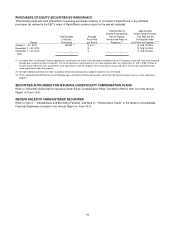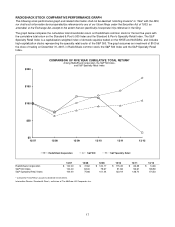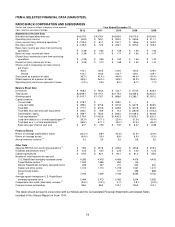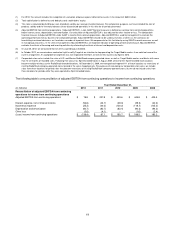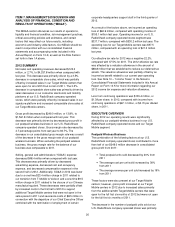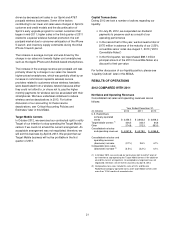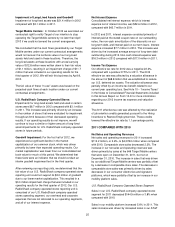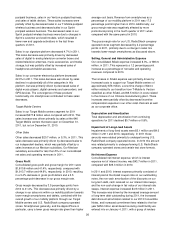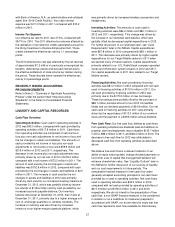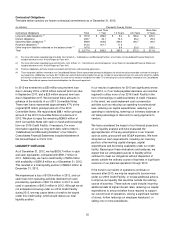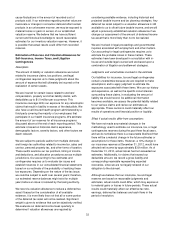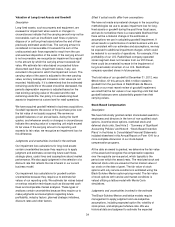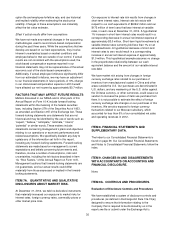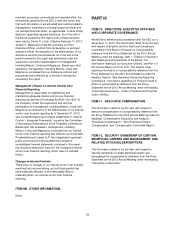Radio Shack 2012 Annual Report Download - page 28
Download and view the complete annual report
Please find page 28 of the 2012 Radio Shack annual report below. You can navigate through the pages in the report by either clicking on the pages listed below, or by using the keyword search tool below to find specific information within the annual report.
26
postpaid business, sales in our Verizon postpaid business,
and sales of tablet devices. These sales increases were
partially offset by decreased sales in our T-Mobile postpaid
wireless business and decreased sales in our Sprint
postpaid wireless business. The decreased sales in our
Sprint postpaid wireless business were due to changes in
Sprint’s customer and credit models, which resulted in
fewer new and upgrade activations in the last three
quarters of 2011.
Sales in our signature platform decreased 4.7% in 2011.
This sales decrease was primarily driven by decreased
sales of digital-to-analog television converter boxes and
related television antennas, music accessories, and media
storage, but was partially offset by increased sales of
headphones and tablet accessories.
Sales in our consumer electronics platform decreased
22.0% in 2011. This sales decrease was driven by sales
declines in substantially all of the categories in this
platform, but was primarily driven by decreased sales of
digital music players, digital cameras and camcorders, and
GPS devices. The convergence of these products’
functionality into smartphones contributed to these sales
decreases.
Target Mobile Centers
Sales in our Target Mobile centers segment for 2011
increased $277.8 million when compared with 2010. This
sales increase was driven primarily by sales at the 646
Target Mobile centers that were open on December 31,
2011, but not on December 31, 2010.
Other Sales
Other sales decreased $20.7 million, or 5.3%, in 2011. This
sales decrease was primarily driven by decreased sales to
our independent dealers, which was partially offset by a
sales increase at our Mexican subsidiary. Our Mexican
subsidiary accounted for less than 5% of our consolidated
net sales and operating revenues in 2011.
Gross Profit
Consolidated gross profit and gross margin for 2011 were
$1,810.8 million and 41.4%, respectively, compared with
$1,913.7 million and 44.9%, respectively, in 2010, resulting
in a 5.4% decrease in gross profit dollars and a 3.5
percentage point decrease in our gross margin rate.
Gross margin decreased by 3.5 percentage points from
2010 to 41.4%. This decrease was primarily driven by a
change in our sales mix within our mobility platform towards
lower-margin smartphones and tablets, combined with the
overall growth of our mobility platform through our Target
Mobile centers and U.S. RadioShack company-operated
stores. Smartphones generally, and the Apple iPhone in
particular, carry a lower gross margin rate given their higher
average cost basis. Revenue from smartphones as a
percentage of our mobility platform in 2011 was 17.3
percentage points higher than in 2010. Additionally, our
gross margin rate was negatively affected by more
promotional pricing in the fourth quarter of 2011 when
compared with the same period in 2010.
The gross margin rate for our U.S. RadioShack company-
operated stores segment decreased by 2.2 percentage
points in 2011, primarily due to a change in sales mix
towards lower-margin smartphones as discussed above.
Selling, General and Administrative Expense
Our consolidated SG&A expense increased 6.3%, or $93.6
million, in 2011. This represents a 1.2 percentage point
increase as a percentage of net sales and operating
revenues compared to 2010.
The increase in SG&A expense was primarily driven by
increased costs to support our Target Mobile centers of
approximately $76 million, a one-time charge of $23.4
million related to our transition from T-Mobile to Verizon
classified as other SG&A, and $9.5 million in costs related
to the closure of our Chinese manufacturing plant. These
increases were partially offset by decreased incentive
compensation expense in our other retail channels as well
as our corporate office.
Depreciation and Amortization
Total depreciation and amortization from continuing
operations for 2011 declined $0.7 million or 0.8%.
Impairment of Long-Lived Assets
Impairments of long-lived assets were $3.1 million and $4.0
million in 2011 and 2010, respectively. In 2011 these
amounts were related primarily to underperforming U.S.
RadioShack company-operated stores. In 2010 this amount
was related primarily to underperforming U.S. RadioShack
company-operated stores and certain test store formats.
Net Interest Expense
Consolidated net interest expense, which is interest
expense net of interest income, was $43.7 million in 2011,
compared with $39.3 million in 2010.
In 2011 and 2010, interest expense primarily consisted of
interest paid at the stated coupon rate on our outstanding
notes, the non-cash amortization of the discounts on our
long-term debt, cash received on our interest rate swaps,
and the non-cash change in fair value of our interest rate
swaps. Interest expense increased $4.9 million in 2011.
This increase was driven by the increased average amount
of long-term debt outstanding during 2011, the increased
debt discount amortization related to our 2013 Convertible
Notes, and increased commitment fees related to the five-
year $450 million asset-based revolving credit facility we
entered into on January 4, 2011, with a group of lenders


